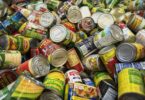Freezing dry food is a recent invention and many people discover its usefulness. What it means is that as you freeze dry your food all moisture and water content is removed from the food. This is different from traditional freezing. With this new method, the nutritional value of the food remains intact. This is exactly what you want when you go camping for days or are blocked from the world for a week or more during a disaster event. You need nutrition more than ever. Otherwise, the structure of the food changes drastically since it turns into hard crumbs.
[the_ad_placement id=”in-text-1-type-r”]You will need warm water to un-freeze and un-dry the food so it becomes edible. There are a few steps to follow for proper freeze-drying, and we will discuss in this article.
You should also know that foods with high content of water are the easiest to freeze-dry. Such foods are fruits and vegetables, e.g. apples, pears, berries, even potatoes, carrots and peppers. Their structure remains intact, and only the water content is removed. Interesting enough you can freeze-dry other food like meat, pasta, oats, etc. Your imagination is your limit. First you will have to learn the method using fruits or vegetables, since it’s easier with them. When you get comfortable with the process, then you can move to other, more complicated, foods.
You need to be aware about freeze-drying meat though. Don’t do this procedure when you’ve just kept the meat in the freezer and removed it from there, or after you bought it from the market. Meat must be freeze-dried right after cooking. This is when all its properties are intact and it will still be edible. If you freeze-dry raw meat, and then after months you decide to eat it and melt it, it will still be raw. And be sure that raw meat is hardly appetizing.
Now, if dry freezing seems a bit too complicated, there is always the option of buying specially designed meal packages. We found some great options on Nomad Nutrition, an emergency food supplier for preppers all over the world. We reached out to them and got you 10% off on all orders (even when you re-order). Just add the SRVMA10 code when you checkout.
The best way to freeze dry your food
First of all, you don’t need some super advanced technique to achieve these results. It is true that there are special vacuum machines which suck out all moisture from the food (and that happens pretty quickly), but that’s not a must. There are other ways to end up with freeze dried food.

Use the freezer! This is an easy way to have freeze dried food. The process may take several weeks, but there’s no more action on your part than just placing the food in the freezer and let it work. Basically, you can chop the food to small pieces and place them on a perforated tray or similar (so there’s as little surface covering the food as possible).
During the first several hours the food will freeze. Then starts the sublimation process (meaning, the drying process). This takes much longer – from one to several weeks. You can test if the food is ready, by taking a frozen piece from the freezer and let it melt. If it turns black then it’s not ready and you need to let it dry more. When the food is fully dried it shouldn’t change its color (especially to black).
If the food doesn’t turn black after melting and keeps its original and natural color, then you’re set up for the final step of storing it.
[the_ad_placement id=”in-text-2-type-r”]Another way to freeze dry food is to use dry ice (CO2). This procedure is similar in concept to the above method. You can just use difference means to achieve what you want. Basically, dry ice lets all moisture evaporate from the food, leaving it freeze-dried. In extremely cold environments there’s almost zero humidity in the atmosphere (as a reference, Antarctica has the driest conditions on Earth).

You will need a very large container, almost twice as the food you will freeze dry. Place the food in large plastic bags and seal them (no dry ice should be able to penetrate the package). Cover the food entirely with the dry ice.
Then place the container in the freezer. The container needs to have a few holes so that the gas and moisture can escape the container. If there’s no more dry ice inside the container, then this is your sign that the food is ready. This should happen with 24 hours so make sure to check regularly.
A word of caution – when you do the above, always wear gloves and protective wear while you handle the dry ice.
You will need to store the food when it’s ready and freeze-dried. The best way is to keep it in plastic bags, but make sure to push the air out, since it contains moisture. You don’t want to keep moisture closed inside with the food. This will speed up the spoiling of the food. You can use a vacuum packing machine if you want to be meticulous. You also should be able to properly seal the bags, so that you’ll be sure that no moisture can find its way inside.
Another popular method is to use a special vacuum chamber but you’ll have to buy one if you want to use this method.
First of all, freeze the food in the freezer (a deep freezer would be even better) and make sure that there is no other food inside – keep only the food you want to freeze-dry later. Let it stay for several hours. Avoid opening the freezer too often since that will slow the process, as ice crystals form very quickly when frozen air meats moist warm air.

When that’s done, remove the frozen food, and immediately place it in the vacuum chamber. Set it to 120 m Torr. The temperature must be 10o C (50o F). Again the process should take at a minimum 1 week, maximum a few more. It all depends on the parameters and how much moisture is in the food. When the sublimation is finished, place the food in storage bags and seal them well.
Then comes the moment when we need to instruct you how to reconstitute your freeze dried food. This process is possibly the easiest of all. You need boiling water (a cup or two) and add it to the food. It will quickly start turning to its original fresh form, since it soaks with all the moisture you removed by following one of the above methods.
A few more details and information about freeze dried food
These details may be of interest to you. When you first freeze the food, it requires a temperature of about -18o C (-0.4s F). Then, in order to make the sublimation process happen, contrary to obvious logic, a warm temperature is needed – it gives energy so that this process can be started. The ice crystals need to evaporate, so a temperature of 35o C (95o F) is needed for this.
Also, while drying in the vacuum container, very low pressure is used. It is needed so that water almost immediately turns from one state (frozen or liquid) to another (gas), and thus evaporates very quickly from the food. Without this process drying would take much longer in normal conditions.

Of course in the traditional method (without using any fancy machines), freezing the food basically makes vacuum to be created around the water molecules. When the food is slightly warmed (for drying) these ice crystals quickly turn to vapor and leave the surface of the food.
Another interesting fact is that water has only two conditions when put in a vacuum chamber (or in any vacuum condition) – it can be either gas or a solid. As the food is frozen (vacuum created), and then moved to a slightly warmer condition, the frozen water can only evaporate as a gas. The thing is that even if the food is not kept in super low freezing temperatures, it still remains in sub-zero condition. That is the key to keeping it frozen, yet letting the water evaporate. This process is the so-called sublimation we mentioned above.
In fact if you use the first method we described above, you won’t need anything special than just a freezer. The first stage is the freezing. Then the water transitions to the second vapor condition and begins evaporating. All the other methods require special chambers or dry ice in order for these two conditions to transition one from the other. As long as you know how water works, you should be able to control the process better.
Also, any type of food can be freeze-dried and you don’t have to worry about the taste or the smell after it is reconstituted. It is even believed that reconstituted freeze-dried food tastes and smells even better than traditionally dried food. The freeze drying process is the one that preserves all the qualities and nutrients in the food. Adding the boiling water only revives the food. The only nutrients that can be depleted somewhat are vitamins C and E, and folic acid. Some amount remains, but most of it can’t withstand this process. That’s why is important to include high-calorie foods in your freezing process. If you don’t know which ones to choose, we have a great list in our article on high-calorie vegetables.
Freeze dried food can last for years. There are people and even markets that store food in this way so it can remain almost untouched by time and then be reconstituted when it needs to be eater or sold. This process is in fact very old and is being used by the Incas. They placed a piece of food during the night to freeze and then keep it in the hot sun for a whole day to dry completely.
[the_ad_placement id=”in-text-3-type-r”]Freeze drying is also popular among hikers and campers since camping requires that you carry a lot of things in your backpack. Food can take a lot of space and make your backpack pretty heavy. If you add a few bottles of water and your main weight comes from food and water. So, substituting traditional food with freeze dried food is actually a great way to enjoy a week or so of trekking or camping without the burdens of heavy weight.
It is also highly advisable that everyone has at least one-year of food stored for some future disasters or economic crises. After all you can’t keep a mere basement with fresh canned food, since it may not all fit in. Here comes the magic of freeze dried food. Since 98% of the moisture in the food is removed, this would also mean that more than 90% of the food’s volume will be removed as well. This makes it great for long-term storing (away from moisture), since it takes very little space. If you want to know more about storing food, take a look at our article on emergency food storage.
If you don’t have the desire to freeze dry your own food you can turn to manufacturers who already sell such food. One such popular brand is Mountain House. It is particularly popular among tourists and campers, but if you need to store food you can buy in bulk from them. And don’t expect that they sell only some bleak freeze dried fruits.
On the contrary, they have whole meals like lasagna, scrambled eggs, cottage cheese and almost everything you can think of. The truth is that almost any type of food can be freeze-dried. Some people even freeze dried ice cream. And to our surprise it worked.

This is why if you take your time and try one of the above methods you can use your own imagination and freeze dry your favorite meals, instead of eating meals you don’t particularly enjoy.
And finally, you can freeze dry meat. One very popular such food is beef jerky. The process is the same and you end up with meat, packed with all its inherent nutrients and is so lightweight that it’s like a paper sheet. You can also do the same with regular cooked beef. So, cook the meat, and then chop it to small pieces. Follow one of the above methods for freeze drying and you will end up with very small hard crumbs (almost like bread crumbs). It wouldn’t even look like beef, but when you add boiled water you will recognize the taste immediately.
Consider freeze drying whenever you go camping or want to store some food for more uncertain days, or just experiment and see how easy it is to complete the process. It’s great to have less room to spare in the fridge when you need to store your food.






I use an in-home freeze dryer which help immensely in the process. I like to store a lot of food and be prepared for a rainy day. This method is the best to store food for long time, which is really an important part of my survival plan.
Hi there :-)
Where did you buy your in-home freeze dryer? Do you perhaps have a website address I can look up?
Thank you!
Harvest Right freeze dryers. We just got one and it works great.
I saw the post you made several months ago in Survival Mastery regarding freeze drying food. Would you please tell me your method of removing the grease in beef and chicken before you freeze dry it? I tried freeze drying a rotisserie chicken and sealed it in a mylar bag and opened it up a few months later to taste it. It did not taste good because it was too greasy and it had gone rancid. Do you have a certain method of removing the grease or any advice for me?
Based on my experience, the foods which I’ve been frozen lasted longer than those I stored in the cooler. However, I was just concerned with the taste. Some foods are no longer as tasty as the fresh ones. Also, I would like to know why are you not supposed to re-freeze food that was already defrosted? Thank you
You can freeze and refreeze food as
long as it has not been left outside the fridge for more than 2 hours
I never really though about dehydrating my own cooked food.
This will help with both taste and quality of the ingredients. Thanks for the article!
Hi Josh, make sure you try it, it’s amazing.
I am using the freezer method right now, and I took out the scrambled eggs from a couple of weeks ago. The color remained the same, but it was still soft, which doesn’t seem right for freeze dried. What is it supposed be like when ready?
Maybe the freezing didn’t go as you had planned, just try doing it again.
If I freeze dry some hot peppers, once they are dry, can I take them out and then grind them up to powder? I know drying them in oven works but you lose some flavor from the heat. I am wondering how the freezing part will work with then grinding them up. Do they starting getting moist again once they are out of the freezer? Do they require any special prep between them being frozen, brought up to room temp, and then grinding them? Any info along those lines would be helpful.
We always called food that was beginning to dry out in the freezer, freezer burned, and it generally didn’t taste very well. It was considered old and was thrown out. How is this different? What am I missing? I would like to be able to make my own meals for long bicycling treks. Thank you.
Consider the following tips:
The freezer should be in a cool, dry, well-ventilated place, on a level surface away from the stove or sun.
The inside temperature should be 0° or lower. Because a refrigerator’s freezer cannot always stay this cold, this type of freezer is best used for short-term storage.
To ensure that food is safely frozen, keep a thermometer in the freezer and check it regularly.
There are modern ways of food preservation aside from freezing nowadays; we have canning and dosing food radiation – processes found to be safe by experts. In spite of the newly introduced methods, my parents still use salt and vinegar in preserving our food to last longer periods. But of course, most of it isn’t dry food. My question is, Are there other means for dry food to be preserved than plainly freezing?
Salting is one of the most popular methods of preserving food, but you can always settle for freezing, pickling, or canning. The method you choose depends on your resources and how much food you want to preserve.